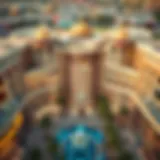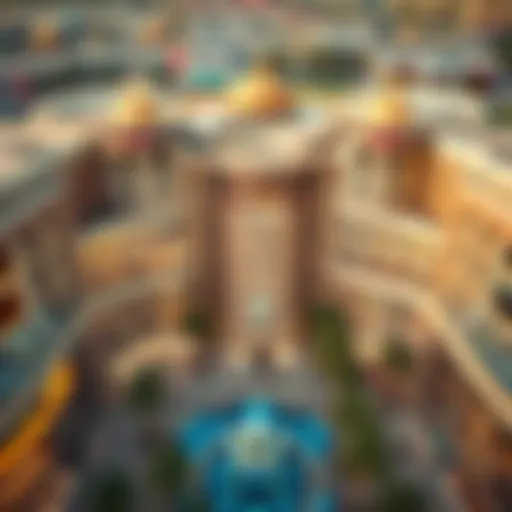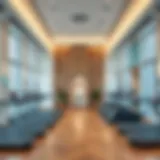In-Depth Look at Dubai Metro's Red Line Impact


Intro
The Red Line of the Dubai Metro is not just an efficient mode of transportation; it embodies the pulse of modern Dubai itself. As one of the backbone infrastructures in a city characterized by rapid development, this Metro line has transformed the urban landscape. This comprehensive analysis will be delving deeper into the implications of the Red Line on various aspects such as urban growth, property dynamics, and future development potential.
This article lays the groundwork by highlighting key discussion points. We will examine how the Metro line has shaped real estate trends, enhanced connectivity in the region, and prompted infrastructural development. Essential insights geared towards investors and homebuyers will also be explored to help navigate the complex dynamics of the Dubai real estate market.
With Dubai poised for continual growth and evolution, understanding the implications of the Red Line is vital for anyone with a stake in the ever-changing landscape of this bustling metropolis.
Market Analysis
Current Trends in Property Prices
While the pulse of Dubai's property market beats a little irregularly at times, the steady growth observed around the Red Line is hard to ignore. As transit-oriented developments rise like mushrooms after rain, property prices in neighborhoods adjacent to Metro stations have witnessed an uptick. Research indicates that homes within a 500-meter radius from a station enjoy premiums ranging from 20% to 30%. This trend emphasizes the undeniable correlation between accessibility and property value.
Prime examples include the Burj Khalifa and Dubai Marina areas, where property values reflect their proximities to the Red Line, creating a hotspot effect.
Future Growth Projections
Looking ahead, forecasts suggest robust development opportunities along the Red Line. Planning agencies and developers are increasingly aligning with public transport frameworks as urban expansion continues.
Several projects touted to shape the future of Dubai are either proposed or under development, signaling strong future growth. Major initiatives include mixed-use developments that blend residential, commercial, and cultural spaces to enhance the livability that Dubai is known for. With efforts such as Dubai’s 2040 Urban Master Plan, one can expect the Red Line to act as a magnet for investors going forward.
"Public transport in Dubai is not simply about moving people; it’s about creating vibrant spaces and communities.”
Quote from Dubai Transport Authority
Buying and Selling Tips
Essential Steps for First-Time Buyers
For those stepping into the real estate market, especially near the Red Line, it’s crucial to know your ducks before you put them in a row. Step one is understanding your financial position and securing financing. Once that’s sorted, researching the local market helps in identifying which neighborhoods align with your investment goals.
Furthermore, engaging a real estate agent who specialize in properties near the Metro can streamline the process tremendously. They can provide insights into the neighborhood trends, ensuring you don’t miss out on a gem. Consider visiting properties at different times, as environments can change from morning till evening.
Strategies for Selling Properties Effectively
When it comes to selling a property close to the Red Line, make sure to highlight the advantages of Metro accessibility. Online listings should emphasize travel times to key destinations and local amenities, giving potential buyers a clear picture of living there. Pricing is an art, not a science; conducting a comparative market analysis can help you position your property competitively.
Additionally, staging your home smartly plays a vital role in attracting buyers. Clean spaces, a touch of greenery, and perhaps even a bit of fresh paint can make a world of difference. You want to showcase a lifestyle that buyers can see themselves living.
In summary, the Red Line is more than just a transit route; it shapes the economic fabric of Dubai. Understanding the interplay between transport and real estate will empower both buyers and sellers to make informed decisions while navigating this vibrant market.
For those interested in further research, consider exploring resources such as Wikipedia, Britannica, and social forums like reddit.com for community insights.
Additionally, official resources such as Dubai's Government website can provide valuable updates on ongoing projects.
Prologue to the Red Line
The Red Line of the Dubai Metro is not just a transportation artery; it's a lifeline for the city's ever-evolving landscape. Connecting the bustling heart of the metropolis to its outer reaches, this metro line exemplifies innovation, urban planning, and economic growth. As we delve into the significance of the Red Line, it becomes clear that it plays a pivotal role in shaping not only the physical infrastructure but also the social and economic dynamics of Dubai.
Overview of the Dubai Metro System
The Dubai Metro system, being one of the world’s most advanced, is designed to cater to the fast-paced lifestyle of its residents and visitors. Stretching to over seventy kilometers, it features two main lines—the Red and the Green, with the former being the longest and most utilized. Launched in 2009, the Red Line brought radical changes to how people navigate the city, making daily commutes swifter and more efficient.
- Current Reach: It runs from Rashidiya to UAE Exchange, serving various significant stations along its path, including Burj Khalifa/Dubai Mall and Deira City Centre.
- State-of-the-Art Features: With driverless trains and an integrated ticketing system, its operation demonstrates a commitment to technology and user convenience. Each station resembles a futuristic design, reflecting Dubai's vision of becoming a global city.
In this context, the Red Line acts as a bridge, connecting various neighborhoods and business districts, thus supporting not just commuting needs but also fostering networking among different communities.
Importance of the Red Line
The Red Line is important for several reasons that paint a broader picture of its functionality and influence:
- Accessibility: By enhancing connectivity, it minimizes travel times across the sprawling urban areas. This accessibility is particularly beneficial for commuters, expats, and tourists, easing movement within the city.
- Economic Revitalization: The metro line has catalyzed commercial growth, with numerous businesses emerging around key stations. Property prices near Red Line stations have also skyrocketed, illustrating the direct correlation between transit access and real estate value.
- Sustainability: As part of Dubai's vision for reducing urban traffic and pollution, utilizing the metro system is more environmentally friendly compared to cars. This transition aligns with global trends in sustainable urban planning.
Overall, the Red Line of the Dubai Metro is a colossal feat of engineering and urban design, reshaping both the physical and economic landscapes of the city. It serves not merely as a transit option but as a significant player in the ongoing narrative of Dubai's growth and development.
Historical Context
The historical context of the Red Line in the Dubai Metro is indispensable for understanding not merely its architectural and operational triumphs but also its overall contribution to the urban fabric of Dubai. Analyzing the historical framework provides insights into how the Metro came into existence amidst various socio-economic transformations. The inception and evolution of the Red Line reveal critical dynamics regarding governance, urban planning, and infrastructural investments, significantly affecting how the city has developed as a global hub.
Development Timeline
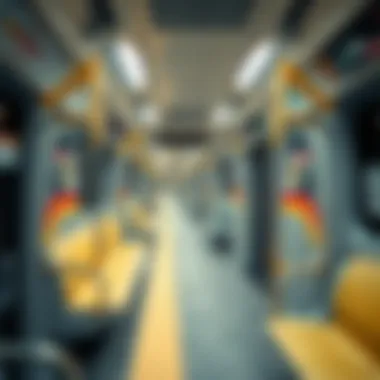
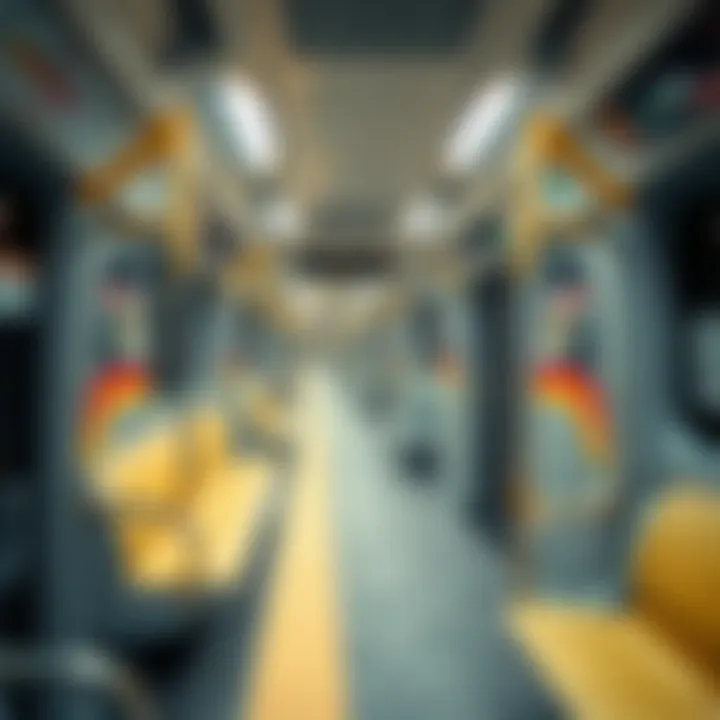
The timeline of the Dubai Metro's Red Line outlines pivotal moments in its development from conceptualization to completion. This journey starts in the early 2000s when the government recognized the need for a robust public transport system to alleviate traffic congestion due to rapid urban sprawl. The groundwork was laid in 2005, and while challenges were plenty, from securing funding to managing logistics, the project forged ahead.
- 2005: The Government of Dubai awarded the contract for the construction of the Metro.
- 2009: The first section of the Red Line was completed, stretching over 52 km.
- 2010: The Metro officially opened to the public, fundamentally shifting daily commutes for residents and tourists alike.
- 2011-2017: Continuous expansions added new stations and connections, integrating the line into Dubai's broader urban strategic framework.
With each phase, the Red Line became a testament to Dubai's ambition and vision for the future, supporting not only local transit needs but also aiming to boost tourism and commerce.
Historical Challenges and Achievements
Despite its successes, the Red Line was not without its share of hurdles. Major challenges faced during its development included the need to coordinate construction amid existing urban infrastructure and overcoming engineering complexities tied to Dubai's unique landscape. Some noteworthy challenges involved:
- Funding and Financing: Initially, securing capital for such an enormous expenditure was a daunting task. The government had to explore various avenues, including public-private partnerships, to make the vision viable.
- Logistical Issues: Working within a bustling metropolis required innovative construction methods, such as implementing elevated sections to minimize disruption to traffic and commercial activities below.
- Technological Challenges: Integrating cutting-edge technology while ensuring the Metro met all safety and operational standards was crucial. The metro system uses advanced automated systems for efficiency and a sustainable approach to transportation.
In terms of achievements, the Red Line stands as a symbol of rapid urban development. The line not only facilitates transportation across the city, but it also plays a role in fostering economic growth and spatial development. Post-launch, areas around the stations witnessed a significant rise in property values, with investors flocking to neighborhoods ripe for development.
In summary, the historical narrative surrounding the Red Line is filled with both challenges that tested the resolve of stakeholders and achievements that highlighted the ingenuity of urban planning. Understanding these elements illuminates how critical the Red Line has been in sculpting Dubai's identity as a modern city.
Key Stations Along the Red Line
The significance of the Key Stations Along the Red Line cannot be overstated—these stops are not merely points on a map, but rather pivotal hubs that bridge various sectors of Dubai. Each station plays a unique role in the urban fabric, ensuring not just connectivity but also fostering economic and social interactions. Understanding these key stations offers valuable insights into the overall efficiency and growth potential of the Dubai Metro system.
Major Stops Explained
Within the realm of the Red Line, several major stops stand out for their strategic importance:
- Rashidiya Station: This station serves as a gateway for residents from the eastern suburbs, offering easy access to the core of the city. Being near major residential areas, its influence on commuter convenience is significant.
- Airport Terminal 1 Station & Airport Terminal 3 Station: These two stops cater to travelers arriving and departing from Dubai International Airport. They link air travel with ground transit effectively, showcasing the combined efficiency of Dubai's transportation network. The ease of access to the airport certainly adds to property values in nearby areas.
- Deira City Centre Station: Situated in one of the oldest parts of Dubai, this station has transformed into a shopping and business hub. The proximity to malls and corporate offices enhances the appeal of the surrounding neighborhoods, making it a hotspot for retail investment.
- Burj Khalifa/Dubai Mall Station: This stop is not just a means to an end; it epitomizes luxury and commerce. The presence of the Burj Khalifa and the Dubai Mall significantly boosts foot traffic, translating to economic prosperity for local businesses.
- UAE Exchange Station: Connecting to the burgeoning Abu Dhabi population, this station is pivotal for those commuting to work. It highlights the interconnectivity between emirates and is expected to influence nearby property developments in the coming years.
The stations of the Red Line are often a microcosm of the city’s broader economic landscape, drawing individuals and businesses alike into their orbit.
Impact of Each Station on Surrounding Areas
The impact of each station is not just felt within its confines; it ripples throughout the surrounding areas, creating various economic and social implications:
- Boost in Real Estate Value: Proximity to a metro station generally increases property values. Areas close to Rashidiya or Deira City Centre have seen a noticeable uptake in property prices post the metro's launch.
- Increased Foot Traffic for Businesses: Stations like Burj Khalifa/Dubai Mall act as magnets for shoppers and tourists. Local retailers benefit from this increased foot traffic, as more visitors translate into higher sales.
- Urban Development: The presence of a metro station often leads to future development projects. Land that was previously underutilized might soon see a plethora of residential and commercial projects. Development around Airport Terminal stations, for example, has already begun to flourish with hotels and offices cropping up.
- Social Connectivity: Beyond economics, these stations create opportunities for communities to engage. Events, festivals, and fairs frequently take place near these hubs, fostering a sense of community among diverse populations.
Key Insight: Studies indicate that properties located within a two-kilometer radius of a metro station appreciate significantly more than those farther away.
Economic Impact of the Red Line
The economic ramifications of the Red Line in the Dubai Metro are substantial and multifaceted. As a key component of the city's urban transit framework, the Red Line does more than just facilitate movement; it plays a vital role in catalyzing local economic growth, influencing real estate trends, and subsequently shaping the broader economic landscape of Dubai. Analyzing this impact is crucial for stakeholders who wish to navigate the intricate relationship between urban transportation and economic opportunities.
The Red Line serves as a backbone for numerous businesses and residential areas. It increases accessibility, which can lead to greater foot traffic in commercial zones, boosting sales and fostering job creation. Moreover, the perceived value of properties located near metro stations tends to rise, often attracting keen interest from both investors and homebuyers.
Effect on Local Business Growth
Local businesses experience a direct benefit from the presence of the Red Line. With easy access to transportation, customers are more likely to visit shops, restaurants, and services located near metro stations. This can lead to enhanced sales and, ultimately, business expansion.
Consider the area around the Burj Khalifa/Dubai Mall station. This location has become a commercial hub, partly due to the flow of visitors using the metro to access these iconic attractions. As a result, small businesses have thrived, creating jobs and stimulating the local economy.
- Increased exposure: Being close to a metro station can enhance a business's visibility to potential customers.
- Diversified clientele: Businesses can attract a mix of local residents and tourists, enriching customer demographics.
- Economic resilience: Well-connected areas like those near the Red Line tend to bounce back more quickly from economic downturns.
Influence on Property Prices
The correlation between the Red Line and property values can't be overstated. Areas in close proximity to metro stations typically see a spike in real estate demand. For example, properties near the Dubai Marina station enjoy higher price appreciation compared to those located farther away.
Factors that contribute to this increase in property prices include:
- Accessibility: Properties close to metro stations are more attractive for investors and tenants looking for convenience.
- Growth potential: Future urban development plans often reference proximity to transit lines, making those areas more appealing for potential homebuyers.
- Infrastructure improvements: The Red Line has prompted additional public and private investment into surrounding neighborhoods, including parks, shops, and amenities, thus increasing property values.
"Metro systems have a unique ability to drive real estate values upward, making investments in transit-oriented development crucial for future city planning and residential growth."
In summary, the economic impact of the Red Line facilitates local business growth and serves as a significant driver for property values, illustrating its importance in the ongoing development of Dubai. Understanding these dynamics is essential for investors, analysts, and homebuyers seeking to leverage the advancements brought about by the metro system.
For further insights, you can explore related topics at Wikipedia, Britannica, or discussions on Reddit.
Urban Development and Planning
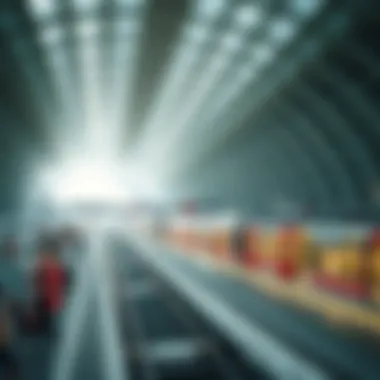
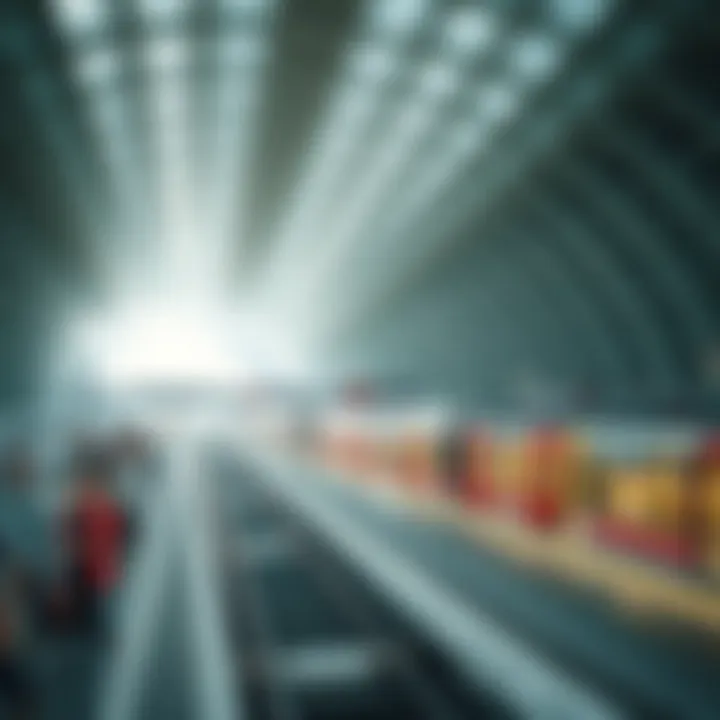
Urban development around the Red Line of the Dubai Metro is not something to take lightly. The synergy between the metro and the developments in its vicinity shapes how the public interacts with urban spaces, influencing both residential and commercial landscapes. This interconnectedness brings forth various benefits, such as increased accessibility, property valuations, and the overall enhancement of living standards in Dubai.
The Red Line serves as a backbone for various development initiatives, facilitating the transition from ideas on paper to concrete realities. Incorporating the allies of planning statutes and smart technologies, the growth aided by the metro system showcases Dubai's commitment to becoming a future-facing metropolis.
Improving urban mobility plays a critical role in urban development plans. A well-structured transportation framework not only eases congestion but visibly elevates the city's image. The ripple effects of these improvements can be seen in property values and business growth. When people consider moving into a neighborhood, access to the metro line often dictates their choice. If they can hop on a train a few blocks away, that community instantly becomes more desirable.
Moreover, urban planners need to blend green spaces, leisure areas, and commercial hubs alongside metro stations. Public areas imbued with parks or recreational facilities attract community gatherings, fostering a sense of belonging. Therefore, keeping these factors in focus is essential for a thriving urban ecosystem.
Integration with Smart City Initiatives
Dubai is not merely a collection of buildings and roads, but a smart city aiming for a sustainable future. The Red Line is a key asset in implementing smart city initiatives that integrate technology into urban planning and infrastructure development. With advantages like improved energy efficiency, reduced environmental impact, and enhanced quality of life, such initiatives elevate the city’s stature as a global leader in urban innovation.
Systems such as the Dubai Smart City initiative encompass various aspects of daily life. For instance, real-time public transport data can reduce waiting times and allow for better scheduling. The application of integrated transport systems adds a layer of convenience for residents, making travel simple and efficient.
Additionally, smart technologies can help in monitoring environmental metrics, providing data that informs future decisions about urban development near the Red Line. This aligns with the city's objective of establishing an eco-friendly environment by mitigating pollution and promoting green practices. The relationship between smart city elements and the Red Line showcases a commitment to blending modern transit infrastructure with cutting-edge technology.
Future Development Projects Near the Red Line
As the Red Line expands, so does the scope for future development projects harnessing its potential. A recent trend in Dubai is the focus on mixed-use developments that combine residential, commercial, and recreational spaces. This concept caters to the increasingly mobile lifestyle of residents who value convenience and proximity to amenities.
Some noteworthy upcoming projects include the development of high-rise buildings that not only showcase architectural innovation but also position themselves strategically near metro stations. For example, the plans for more upscale housing adjacent to notable stations aim to draw in professionals working in Dubai’s bustling commercial hubs.
Additionally, developments focused on sustainability are beginning to take shape. With features like impactful landscaping and efficient water management systems, these projects strive to minimize environmental footprints while enhancing the overall community appeal. This approach aligns with broader efforts from the government and developers to create a greener, innovative urban landscape.
"The path to sustainable urban growth is paved not only in bricks and mortar but in forward-thinking strategies that prioritize inclusivity and innovation."
For further reading, please refer to links like Dubai Municipality and Dubai Smart City, which delve into local urban planning initiatives.
Challenges Facing the Red Line
The Red Line of the Dubai Metro has been a catalyst for transformation within the urban environment of the city. However, this ambitious venture has not been free of its tribulations. Understanding the challenges facing the Red Line provides insights not only into its operational efficacy but also into its long-term viability as a transit solution in a rapidly growing metropolis. Each difficulty encountered can act as a compass for improvements and future decisions, ensuring that the infrastructure meets the evolving demands of its users.
Operational Issues
In the bustling landscape of Dubai, operational issues can easily arise within a public transportation system that plays a central role in everyday travel. One of the primary concerns involves the frequency and reliability of train services. Passengers expect trains to run precisely on schedule; any delays can trigger frustration, particularly during peak hours when the metro is most crowded. That being said, the Dubai Metro is often hailed for its efficiency, yet even the best-laid plans can fall prey to unforeseen interruptions. For instance, maintenance work or system failures can disrupt flow, leading to cascading delays.
Additionally, system capacity is a pressing operational hurdle. As the population grows and the number of passengers increases, the Red Line must accommodate a higher volume of riders without compromising service quality. When trains are at full capacity, the concern then turns to whether enough carriages are in operation to prevent commuters from being left at the platform, particularly during busy times.
Moreover, on top of the technical operational side, safety concerns remain paramount. Passengers expect a high level of safety and security while using the metro. Random incidents or accidents can create apprehension and reduce overall ridership. Therefore, maintaining operational integrity isn't merely about keeping the trains running; it's about fostering a safe and reliable environment for all.
Funding and Maintenance Challenges
The financial underpinnings of the Red Line introduce another layer of complexity. Adequate funding is essential not just for daily operations, but also for proactive maintenance and future expansions. The initial launch of the Red Line involved significant investments, resulting in sprawling infrastructure. However, the challenge lies in sustaining this infrastructure over time, which can be exorbitantly expensive.
Moreover, as systems age, they require strategic maintenance to ensure they function smoothly. This includes everything from routine repairs to major overhauls that can cost millions of dirhams. Such expenses must be accounted for in operational budgets, and sourcing funding can become a tricky endeavor in a fluctuating economy. The interdependence of funding, maintenance, and public expectations requires balancing acts that can become overwhelming, especially in a context where the demand for growth is insatiable.
"Understanding challenges is the first step toward building a more resilient transportation future."
For those interested in further insights on the topic, resources such as Wikipedia and the Dubai Government Portal can provide additional details about the operational aspects and challenges associated with urban transit.
Red Line as a Catalyst for Change
The Red Line of the Dubai Metro is not simply a transportation line; it serves as a vital catalyst for transformative change both in the urban landscape and in the economic fabric of Dubai. This section delves into how the Red Line encourages growth, enhances living standards, and facilitates urban development. The interplay between effective transportation and urban growth is increasingly being recognized as fundamental, and the Red Line stands at the forefront of this change.
Network Expansion Plans
As the skyline of Dubai continues to evolve, so does the ambition behind the Metro's Red Line. Future expansion plans aim to connect underdeveloped areas and create additional nodes that will serve residential and commercial needs alike. By extending the line further into areas like Jebel Ali and Dubai Investment Park, the city's planners are looking to tap into previously inaccessible regions. This expansion is essential for a few reasons:
- Increased connectivity: As more neighborhoods gain direct access to Metro stations, residents can enjoy reduced travel time to major commercial districts and leisure hubs.
- Boost for economic activity: New stations can usher in a wave of business opportunities. For instance, small to medium enterprises could flourish around the newly developed stations, enhancing job creation.
- Property value surge: Areas near extended Metro lines often see an increase in property desirability. Buyers can expect higher returns on investments as connectivity improves, making it a golden opportunity for investors.
An example of this patterned growth can be seen in areas like Dubai Marina, where property values have risen significantly alongside the introduction of nearby Metro stations.
Enhancing Accessibility and Mobility
One of the most noteworthy impacts of the Red Line is its role in enhancing accessibility throughout Dubai. Beyond merely providing convenience for daily commuters, it creates a more interconnected city. The implications for residents, investors, and businesses are considerable:
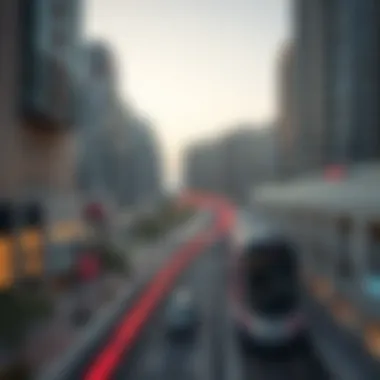
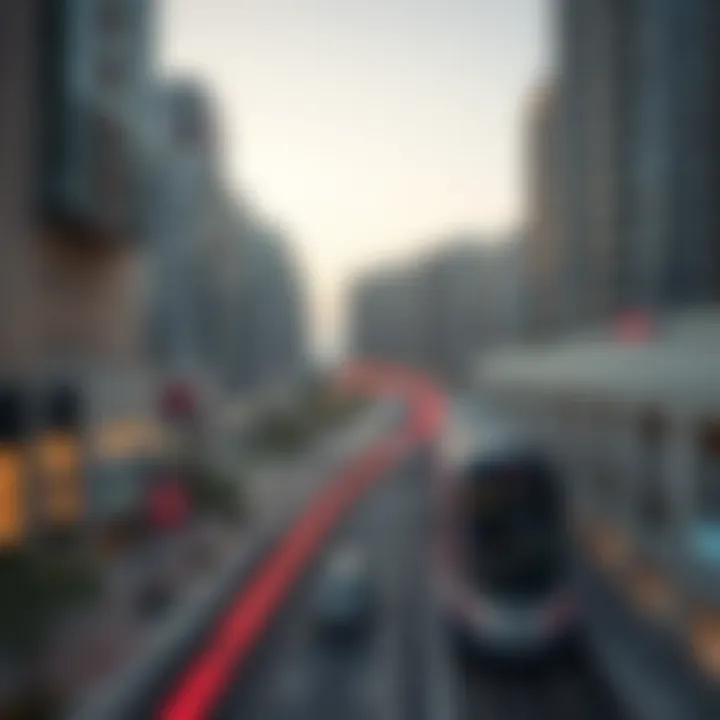
- Universal access: Enhanced mobility creates a more inclusive environment. People from different backgrounds can easily navigate around the city, accessing workplaces, schools, and health facilities without excessive barriers.
- Reduced reliance on cars: The Red Line encourages a shift away from personal vehicle dependency, promoting a more sustainable lifestyle that aligns with global green initiatives. This can dramatically decrease traffic congestion in the long term.
- Time efficiency: Commuters are discovering that reaching their destinations is quicker than ever before, allowing them to reclaim precious time in their busy lives.
"A well-structured public transit system like the Red Line is not just a necessity, it’s the backbone of a city that aspires for modernity."
By giving residents the option to bypass the often-chaotic roadways of Dubai, the Red Line is making strides towards cultivating a culture of mobility that is rooted in public transport rather than individual vehicle ownership. The long-term expectation is a holistic improvement of urban living standards, which is paramount for the continuing development of Dubai as a leading global city.
Comparison with Other Cities' Metro Systems
Exploring the comparison of the Red Line in the Dubai Metro with metro systems in other cities is essential for several reasons. Firstly, it offers valuable insights into how different cities approach urban transportation and infrastructure challenges. Secondly, understanding these dynamics can illuminate the unique strengths and weaknesses of the Dubai Metro, helping stakeholders—like investors and urban planners—make informed decisions. Finally, it places Dubai in a broader context, showcasing its growth ambitions and operational efficiency.
Key Differences and Similarities
When examining the Red Line alongside other notable metro systems globally, several key differences and similarities emerge:
- Technology and Innovation: The Dubai Metro stands out in terms of technology with its fully automated system. Cities like Tokyo and Paris, while offering extensive networks, integrate human operators in various capacities. This autonomy in Dubai enables a smooth operational flow and heightened frequency, which is particularly advantageous in meeting the growing urban demands.
- Design and Layout: The layout of the Red Line, stretching over 52 kilometers and containing 29 stations, offers both convenience and efficiency. In contrast, cities such as New York have a more labyrinthine system. While New York might have an extensive reach, its complexity can be daunting for novice riders, whereas Dubai's streamlined approach caters well to tourists and residents alike.
- Cultural Integration: Dubai prioritizes themes of modernity and luxury in its metro design, featuring high-end stations with advanced amenities. Contrastingly, cities with rich cultural histories, like London, have seen their metro systems evolve while maintaining a blend of historical and modern design, which may appeal differently to their respective populations.
Lessons Learned from Global Practices
Studying the Red Line in Dubai relative to other cities offers pragmatic lessons that can help guide future urban transport decisions:
- Investment in Infrastructure:
Many successful metro systems worldwide demonstrate that robust investment in infrastructure and technology pays off. Approaches from cities like Singapore, which have built metro systems that emphasize sustainability and user experience, can be mirrored in Dubai’s future transportation expansions. - Public Engagement and Accessibility:
In cities such as Melbourne, accessibility to all populations is prioritized, providing essential lessons for Dubai. Ensuring that metro systems cater to individuals with disabilities and are easy to navigate can significantly improve public satisfaction and use. - Environmental Considerations:
Cities like Stockholm have integrated environmentally friendly technologies within their transit systems. As Dubai continues to grow, considering such sustainable practices can enhance public perception while addressing global environmental challenges.
In summation, the comparisons of Dubai's Red Line with other metro systems show unique attributes while suggesting crucial lessons that can shape the future of urban transportation in Dubai. When cities learn from one another’s successes and failures, they can carve out effective solutions that cater to their unique challenges.
"Transportation is the lifeblood of urban living, impacting everything from real estate values to quality of life." - Urban Planning Perspective
For more insights into global metro systems, visit Wikipedia or explore in-depth analyses on Britannica.
For discussions and community insights about these systems, sites like Reddit can be enlightening.
Environmental Considerations
Environmental considerations are at the heart of contemporary urban planning, especially in rapidly developing regions like Dubai. The Red Line of the Dubai Metro has significantly influenced this aspect, demonstrating how modern transportation systems can align with sustainability goals. This section will delve into the importance of sustainability in metro operations and examine the impact of the Red Line on urban air quality.
Sustainability in Metro Operations
The operational strategy of the Red Line exemplifies a commitment to sustainable practices. Energy efficiency is one of the cornerstones of the metro system. For instance, the trains utilize energy-efficient technologies that reduce energy consumption without compromising service quality. Furthermore, initiatives such as regenerative braking allow trains to convert kinetic energy back into electricity, thus lowering overall energy use.
Moreover, the construction materials used in building the metro stations were chosen with environmental sustainability in mind. A significant portion of the materials contains recycled content, minimizing the need for new resources. The stations are also designed to optimize natural light, reducing the reliance on artificial lighting and thereby conserving energy.
"Integrating sustainable practices into public transportation not only enhances operational efficiencies but also contributes to a larger vision of environmental stewardship."
Additionally, the metro stations have facilities for managing waste effectively, prioritizing recycling and composting. This comprehensive waste management helps in reducing the environmental footprint associated with construction and daily operation.
Impact on Urban Air Quality
The introduction of the Red Line has had a positive effect on urban air quality in Dubai. By offering an efficient and cost-effective public transportation alternative, the metro encourages a shift away from private vehicle use. This is particularly crucial in a city where traffic congestion often leads to increased emissions from cars.
Data shows that areas served by the Red Line have experienced a decline in vehicular emissions. Consequently, this reduction contributes to better air quality standards, enhancing public health and the overall urban environment. Metro users report lower instances of respiratory issues, attributing part of this improvement to decreased pollution levels around key transit areas.
In addition to lowering pollution from vehicles, the metro system's infrastructure promotes greater walkability within neighborhoods. With more people encouraged to use public transport, the need for sprawling parking lots diminishes, leading to greener urban spaces that absorb carbon dioxide and improve air quality.
The benefits of improved air quality extend beyond the immediate vicinity of the metro stations. As the municipality aims to reduce its carbon footprint, initiatives associated with the Red Line align with broader environmental goals set by the government, ultimately contributing to a more sustainable future for Dubai.
Ending and Future Prospects
The conclusion of this analysis is not just about summing up the findings. Instead, it sheds light on the pivotal role that the Red Line plays within Dubai’s urban landscape. As we’ve explored, the Red Line is more than just a mode of transport; it’s a backbone of Dubai’s urban development, interconnecting vital economic zones and enhancing the livability of the region. Its influence extends to various aspects of urban life, making it essential for investors, developers, and city planners to understand its trajectory moving forward.
Summarizing Key Findings
Throughout our exploration, several key points have emerged:
- Strategic Importance: The Red Line’s strategic layout enables efficient connectivity between major commercial, residential, and recreational hubs.
- Economic Stimulus: The effect on local businesses has been significant, with proximity to stations boosting foot traffic and enhancing visibility for storefronts.
- Property Values: There exists a notable correlation between station proximity and rising property values, underscoring the Red Line’s impact on real estate trends.
- Environmental Benefits: Transitioning to mass transit options, such as the Red Line, alleviates road congestion, leading to decreased emissions and better air quality over time.
Each of these findings portrays a complex yet coherent picture of how the Red Line contributes to the urban fabric of Dubai, making it essential for stakeholders to recognize and utilize its potential in future planning.
Expectations for Red Line Development
Looking ahead, several anticipations can be made regarding the continued evolution of the Red Line:
- Expansion Plans: With urban expansion being a priority, there are hints that the Red Line may see further extensions that will link even more regions of Dubai, fostering growth in previously underserved areas.
- Integration of Technology: Future developments will likely harness smart transport technologies, aiming for a user-friendly, interconnected experience that appeals to the tech-savvy population.
- Sustainability Initiatives: Alignment with aspirations for sustainability will be paramount, including potential investments in greener technologies to minimize carbon footprints further.
- Increased capacity and efficiency: As demand rises, measures to enhance service frequency and streamline operations will be necessary to accommodate the city’s growing population.
A forward-thinking approach to urban transport infrastructure can create ripple effects, enhancing not only property values but also the overall quality of life.




